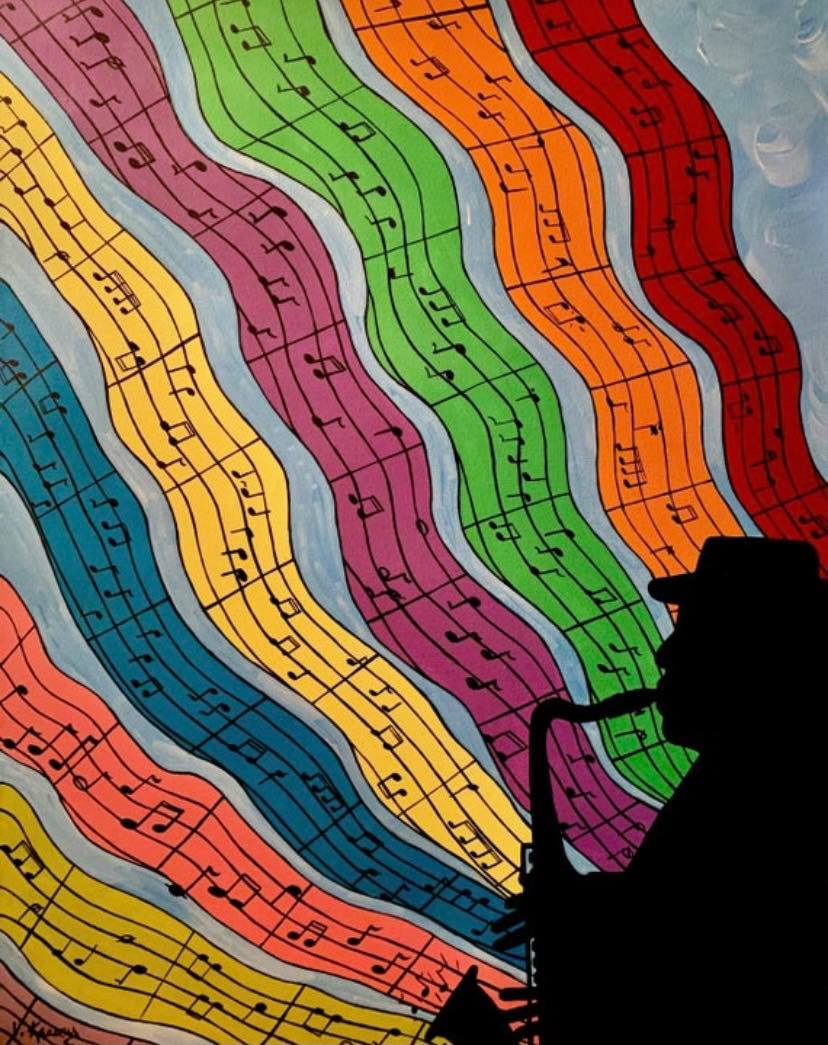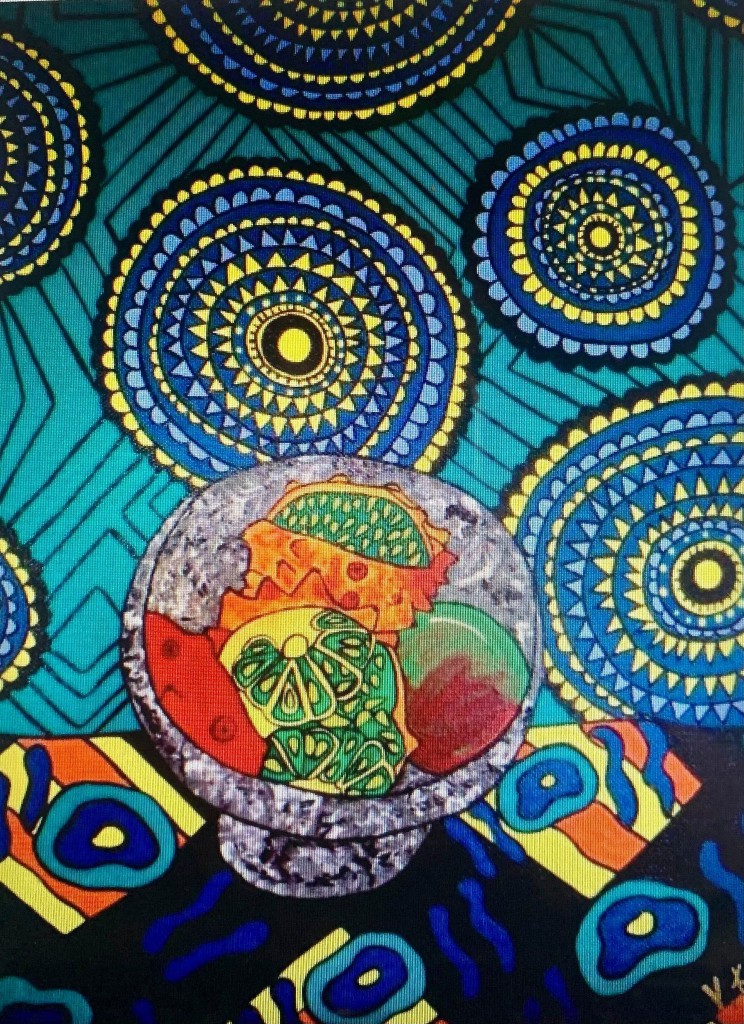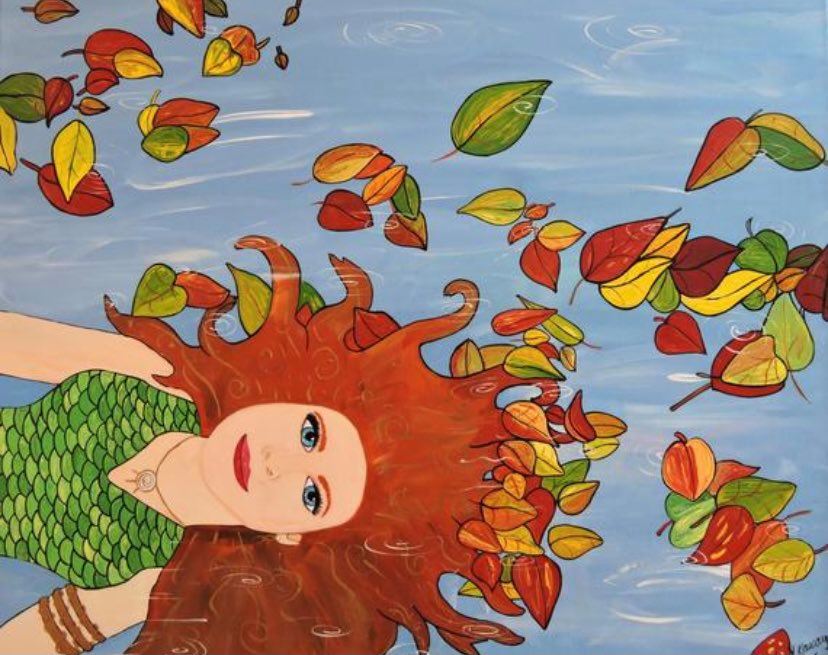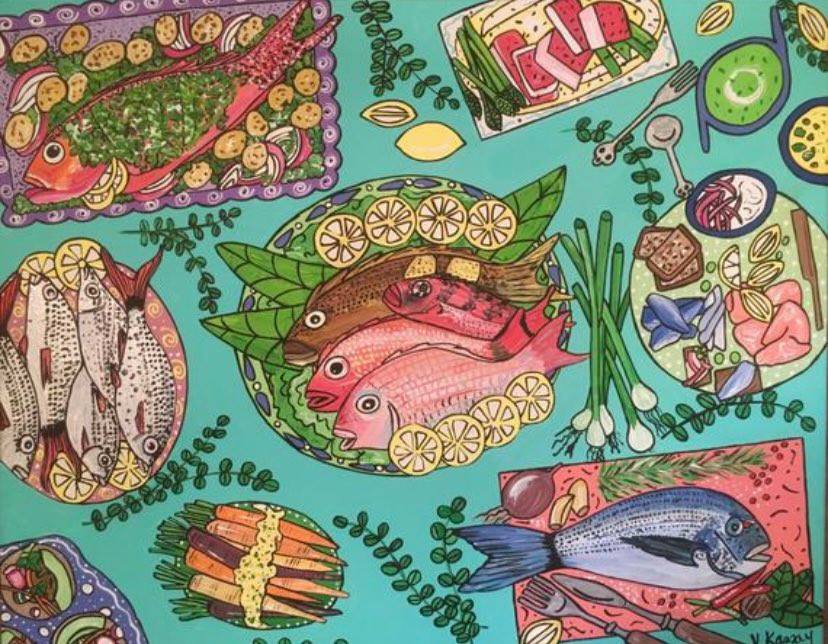Virginia Kassay
It was 2006, my daughter Emily was 6yrs old. She has autism and lost all of her speech and communication skills before 18mths old, then regressed into a world of her own. I was lying on her bedroom floor one day, she crawled up on my back and watched me draw on her magnadoodle. I had captured her attention for the first time in her life and I knew then I was on to something. I had never painted in my life but I knew she liked color and a lot of it so I set out to create images she might be interested in to get her attention…..It worked. I painted on canvas for the first time when i was 39 (I am 54 now), all the things that interested her. I started at the kitchen table transposing paper images to the canvas I worked on. She would runover to the table and watch me. One day Emily pointed to something on the paper I had drawn on as if to ask me where it was going to go on the canvas and I cried my eyes out with joy. I painted about our trip to the supermarket and things in her world. I drew her in by entering her world. We played eye spy with my art and then one day I taught her how to point on cue and make eye contact. I knew I had gotten her back and I have never had a more joyous moment in my life. I took my art to her school to share with her class thinking they might enjoy it as well. The principal saw me carrying the art down the hall and stopped me. She asked me if I had created them and asked me to spread them out on the floor leaning the artwork up against the wall so she could view them. She loved them, each and every one of them. It was the first time anyone else had seen my new found talent. She asked me if I would share them with the whole school and perhaps speak a few words about my daughter to them. One week later I displayed my art for the first time in public and spoke in front of an audience of 100 or more children and adults. With TV cameras (WFMY-News 2) in the clerestory of Emily’s school I gave my very first speech about autism. From there I went on to create and speak more to the public about Emily and her disorder but instead of being sad about it I left people with a positive message about autism using my art to show the world, Emily’s world.
In 2007 Energizer Corp, named me one of the top ten finalists in the United States in the Energizer Hall Of fame contest for the use of my art in a positive way to heal my daughter and show the world the beautiful side of autism. I have been on Channel 2 WFMY-News many times since then and have had many articles written about Emily and I. I have exhibited my art in such places as Sci-Works museum, Davidson College, Wake Forest Baptist Medical center as well as many ,many other places. I started painting gourd bird houses last year because I ran out of space in my house with all the canvas works I have created 🙂 now i use the ceiling to hang the gourds so i have plenty of room for them :-)I make something out of nothing and that in itself is the best gift of all. I love to create, not a minute goes by that I don’t think about making something so my mind never rests. Thank you for taking time to read about me 🙂 You can find my very first children’s eBook called “The Big Adventure of the Little Leaf ” on Amazon.com, and iTunes.
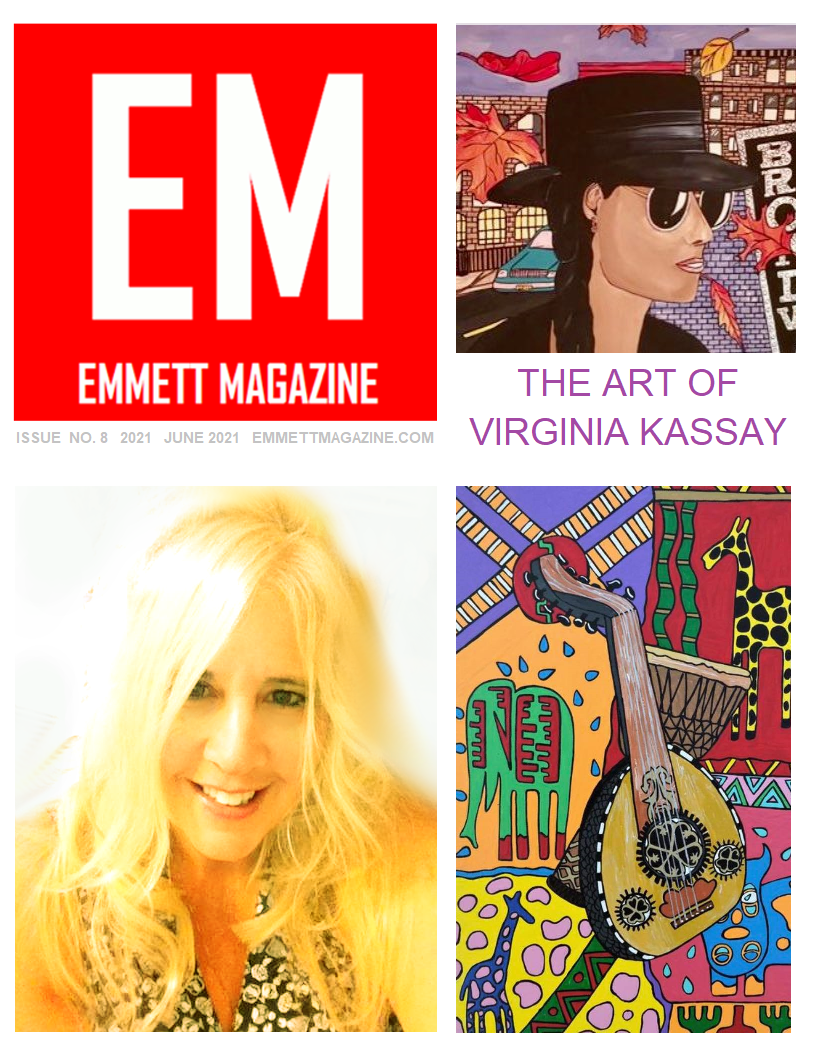
Virginia Kassay Q & A Emmett Williams
EMMETT where were you born and raised?
“I was born in Washington, D.C.”
How old are you?
“I am fifty-eight years old.”
Tell me about your parents, were they creative types?
“My mother was a Registered Nurse. When she was young, she was being trained to be a concert pianist.
My father, his goal was to be an architect, but he went to war twice, so, that dream never came true.
He was a Golden Gloves boxing champ in his youth.
You can say he was the creative type, a “Knock-out artist.”
(Emmett laughs)
He was the type of guy that everyone loved.
Being his son was like being in the company of a famous boxer.
Every time he walked down the street, he was swarmed by a bunch of kids,
before he could make it to his own house. His father was an artist who became a businessperson. He owned a barber shop/beauty salon.”
How many siblings if any do you have? Are they creative as well?
There were six of us, plus mom and pop. My father died when I was seven years old.
Everyone in my family is good at something.
For instance, my little brother is a business wiz and my sister is a fashion designer.”
What types of things interested you as a child?
“Rock ‘Em Sock ‘Em Robots, my slinky, magic cards and one of my favorites was Dr. Seuss Draw Along.
It was cool because you finished a Dr. Seuss drawing and colored it, and the last four pages were blank.
I think it said something like “Now you do something.” And I never stopped.”
What is your favorite memory from your childhood?
Selling comic book paintings that I created at age thirteen, for $250 a pop.
Tell me about yourself. What type of person are you?
“I am a real piece of work. Driven. Focused. I don’t dream anymore. I just direct the dream while I’m in it.
I influence how it comes out. I like to run the show.”
Were you formally trained as an artist? Or is your talent completely raw?
“I would say that I have had formal training by studying sketches by the masters,
and paintings in the library books for free.
I also have paid thousands to frustrated educators in institutions,
who gave up on their dreams, and taught me by default, never to do that.”
Does your style reflect that of other Artist or other artists, or is it uniquely your own?
‘I think art is like dance. If you go back in history,
not a whole lot is really that original. It’s all a part of our cultural ancestry.
Also, it’s marketing and that word “genius” being attributed to people
and the work that makes them “seem” greater in the present.
I am a cubist, and neither I, nor Picasso, created Cubism.
African artisans created the history of Cubism.
They did it in 3-D sculptures and masks. Picasso studied them, and I studied Picasso.
I also studied Duchamp and Braque, plus every other competent painter
who had popularized the real genius of African art.
In books written on Picasso, he references Cubism as “African art” more than once.
I found it refreshing to see those words.
Later on, it seems he was less generous about their role.
Fact is, the two artists essentially starved in Paris, sacrificing funds they could have eaten with.
They instead, bought up all the African sculptures and masks that they could.
I, as a painter, I appreciated the power and complexity of Cubism,
having grown bored with Impressionism.
I believe that Impressionism is attributable to Asian printmaking skills.
There are two modern “so-called” styles that I think have been over-looked.
They are the byproducts of art created from wood.
Impressionist painters mimicked the Japanese Wood-Block printing technique.
African wood sculptures and masks were mimicked by Braque and Picasso.”
In your opinion, what is the most interesting piece of art that you have created?
“I would say that the Chair Art Series of imagery that I created was the most interesting.
I call it “PapaMamaBaba.”
(I own the trademark as well), I was applying sketches of it on my luggage,
brief cases and jackets, when a furniture executive walked in.
It was Christmas Eve. I had no heat. I created in a downtown building that I seized for myself.
In about 30 minutes, I was bought out of everything that I had created,
and it was all being loaded into his car.
He walked back into my studio a few minutes later and wanted
to sign over his Christmas bonus to commission more.
A couple of months went by. The High Point Furniture Market was quickly approaching.
The guy who bought me out, had three chairs delivered to my studio.
He asked that I choose three of my genres and draw them with marker on his chairs.
I could have had a reflex reaction and just did what I already knew how to do,
but instead, I decided not to use the markers.
I sat and thought a while until I had a new approach to offer
that could not be duplicated by anyone else.
I scanned the Internet for everything there was about leather.
I came across a term in an artist’s handbook that read
“ Trompe-L’oile”. I applied the concept to my imagery
and my imagery to the leather, to make anyone else’s future claim to it seem absolutely absurd.”
What inspires you to create?
“Money. Money inspires me to create. I have a desire
to change the stereotypes about artists that still endure today.
I enjoy the exchange of art for payment. Some people dismiss artists and or try to judge us.
Here are a few examples for you regarding the importance of the role of artists in today’s society.
There is enough material for a suit, a sewing machine all set up for you to use,
and all you have to do is make the suit and apply for a job with said suit within twenty four hours.
Will you show up naked or dressed in new suit? How important is the designer in this process?
How about this? There is a mechanic, and engineer and an assembly line ready to build you a car.
How important is the designer in this process?
Or, there is enough lumber and machinery to build your dream home.
Are you able to create every item needed,
that goes into building a new house? Of course not,
that’s why there are designers and Artists.
People with the vision that you lack, to complete this and
many other jobs out there that require a person with artistic skills.
Guess what?? What if those who are skilled in creating mansions,
Ferraris and haute couture fashions for you to wear,
where born with weak spines and
allowed others to talk them out of their destiny’s?
What then? Instead of soaring, what if they give up on themselves and
non-creative people to cannibalize all things that were the epitome of innovation,
fifty years ago?
Furniture and all things as we know them now and in the future,
be at a creative stand still.”
When do you find, are the times, that you come up with your best ideas?
“Between 2am and 4 am.”
How did the death of your beloved wife of ten years, affect you as an artist?
“Our history was one of evolution.
It involved constant discussions of what was needed to get to
whatever the next level was for both of our careers and in our home life.
That usually involved talks about getting press coverage.
But frankly, I’d been there and done that.
Our “eureka” moment was when we agreed that I ought to try and
connect directly with buyers by writing about their work.
My wife had read a short story that I had written for a website,
and she could not stop talking about it.
To me, she was the first person to point out that my style
of writing could be an extension of my artwork. And then shockingly, we agreed
that a graphic novel would be the direction to head in.
There is more to selling art than painting a picture.
That was the ultimate realization for me.
And depending on even a “willing” press, is still dependence.
After my wife passed, I worked on my magazine.
I self-branded it like I wanted the logo to be remembered for the next 500 years.
I used it to distract me from the painful five-year long memories that flooded my brain.
I had to deal with the legal drama with the family I was married into.
It was overwhelming. I was told that I had no chance of winning a case
I had against her family, from three lawyers, one of which was mine.
I am the type of person who has always been told what I can’t do,
by so-called “wise” people, yet I have always won anyway.
As a child I focused on King David.
I saw each and every obstacle as Goliath, big and threatening.
So as long as I knew that I was David in the scenario,
I knew my obstacles were as good as conquered on arrival.
When did you come up with the idea for EM?
“I actually came up with the idea for doing a magazine about fifteen years ago,
but I allowed myself to be talked out of naming it after me.
I’d been creating comics since I was around eight years old.
Older and wiser now, I realized that maybe other people
would be interested in the same artists that I was interested in.
I just needed to change my Cubist experience of assembling images,
my comic book skills and writing skills, into a magazine format.
Instead of creating interesting characters, I found real characters that are interesting.
Then I could introduce the artwork of my friends and colleagues to the world as well.”
You have no formal training in the magazine publishing industry. Do see EM becoming a great success despite your limited knowledge?
“I decided that whatever every other publication out there was doing, it was leading them into the abyss.
Whatever their beginnings, whatever got their publications off the ground,
were now dead and buried. In order to achieve anything,
you have to have a vision or be a visionary to lead it to success.
I just decided to stop listening to people and
stop asking permission to do great things.
I don’t know the formalities of creating a magazine,
according to past standards. Most of the newspapers and magazines I grew up with
are no longer in publication. I will run my magazine the way I run everything in my life.
I wake up every day and before I repeat the day before, I wonder to myself,
if there is a better more efficient way to get what I need to get done.
Is there a smarter, cheaper, faster way. I see it as the more wasted time I recover in a day,
the more I can refocus on being more effective.
I ask myself these questions:
Who has the skills, I need to add to it?
Who do I really want to know about?
What can I offer them to get what I want?
What is going on in the world that is worth talking about?
Whose artwork, if not my own, would I want to see on the pages of my magazine?
Do I need to go outside of my comfort zone and seek people outside the U.S. to write for me?
I know “So and So” paints, do they have any other skills that can contribute to my magazine?
Do you create anything besides canvas art?
I know we touched on the furniture industry a little while back in the interview.
Maybe you can elaborate?
I hand-painted leather furniture, instead of using markers like I had originally used in the beginning.
I started around 2003 with North Carolina furniture companies.
Now I design my own furniture prototypes and am in the process of creating the pieces I designed.
I need to find people who can sew leather and build my designs better than I can.
I also enjoy welding steel sculptures, but I find myself unable to part with them.
I sold all but one that I just can’t let go of. I like working with wire.
I also like working with ceramics, but the piece I created that I loved the most,
broke into pieces in my hands. I think I need to go to fiberglass.
I love making plastic sculptures. I just want to make them on a giant scale.”
Who are your favorite artists? And why?
“Painters would be Marcel Duchamp, Frida Kahlo, Salvador Dali, Pablo Picasso, Jacob Lawrence and Tamara de Lempicka.
If I had to name my top two, they would be Duchamp and DeLempicka.
When was around eleven or twelve, I was refused participation in a life drawing class.
So instead, I started studying books by the masters from the library.
Once I saw what was in the books, I had no intention of giving them back.
I became obsessed with the descending the staircase by Duchamp.
I though it was incredibly interesting, as it a power of me, and conveyed complex movement in one frame.
I had seen a ton of Picasso’s works and although they were powerful and
compelling, they did not have the sublime grace that this one painting by Duchamp did.
So something called “Library Amnesty” was created. Seemingly just for me.
I returned the Picasso books, and paid for the Duchamp books that I refused to return.”
“How I see these artists works”:
“Dali- Unpredictable and visually compelling
Picasso- Powerful
Jacob Lawrence- Not a cartoonist, but he has excellent story-telling techniques, powerful and unique.
Kahlo- She turns tragedy into treasure. She depicts her own unconquerable will and spirit in her works.
DeLempicka- Power and beauty.”
“I worked in a museum which exhibited DeLempicka.
I felt more comfortable turning my drawings into beautiful cubist woman after viewing what they called “Deco”.
It was Cubism, pure and simple, but for some reason,
it seemed that the art world wanted to reserve the term “Cubism”, for Picasso alone.
So they gave her work a prettier, more feminine adjective, which in my opinion is ridiculous.
I’ve heard it said that she “painted like a man.” No.
She was a Cubist, so she painted like a Cubist and
the models were both beautiful and powerful at the same time.
I saw her works in person, seemed to almost give me permission to do
whatever the bleep I needed to do, to have my imagery pop off the walls.”
“Cartoonists/Illustrators”:
Jack Kirby, John Romita, Steve Ditko, Alex Ross and Charles Schulz.
I chose these people for their talent and their decency.
I saw their works regarding African Americans and they are respectful.
Also, in a time when no one else dared to depict other races with respect,
they did and or still do.”
“ If I was on an deserted island and had to choose one, it would be Jack Kirby.
In my opinion, still seeing his output from fifty years ago or more,
he is ten times better than most of the best comic book creators
there have ever been and ever will be. Inked or not. If I could wake up and be able to tell my untold
stories as efficiently as Kirby, I would care less about comparisons and just do it.
The process is o time consuming that you just must have a visionary
team on the same page (metaphor) what worked for Disney
in animation worked for Marvel, the House-Style concept is not only a
time-saver it is necessary, and excellent training for anyone
studying the Master, Jack Kirby. The entire genre of “Pop Art”
was inspired (nice word), by his imagery.”
How often do you create?
“I create in numerous forms these days. Fifty percent writing,
twenty-five percent layout/cover design and the rest is art/laborious inking,
of stories still trying to get told properly. I am not the best inker,
so I try to keep it simple but interesting in order to move the story along.”
Do you feel the need to create on a daily basis? What happens if you can’t?
“That never happens. If I’m out of town, I would compel someone
to give me some paper and a pen. I do something creative every day.
I can go for months without the urge to create a painting,
but I draw twenty to thirty images every single day.”
Please tell me some of the places that you have exhibited.
“WFMY news2 on “The Good Morning Show Gallery” which featured my piece called
“The Blues guitarist.” Web traffic crashed my site and it sold by the end of the day.
I was also a guest on the show.”
“The Greenville Museum of Art in North Carolina in an exhibition.
Cubist Woman. The Bass Player, Modern Mona and Still Life No. 7
were the pieces that I exhibited. It was a group exhibition called
“Living Artists of North Carolina.”
I got to show with my friend Floyd Newkirk and other North Carolina notables.”
“The “Phoenix Home and Garden Expo”. My original artwork and hand-painted furniture
sold out twice as the company re-ordered the sold furniture and then sold that.”
And at “The Bellagio Hotel and Casino”, were four hand-painted chairs commissioned
by a New York designer with my art on them that were exhibited.
Which of your exhibits was your favorite, and why?
“ STREETFACE” an urban experience, in 2019. It was a solo exhibition,
my last exhibit for a couple of reasons. My wife was in it with me for one.
She was a lawyer by trade, but she taught herself how to make molds and casted items,
excelling in her craft even through her cancers.
I don’t humor anyone when it comes to joint exhibitions,
where I have the final say, but she was worthy. I was one of her only subjects,
and she made some casts of my face. With those casts,
we then collaborated on a 3-D piece for the “STREETFACE” exhibit,
which was the theme of the show. A few of her colleagues from her job came through,
and we also created our own playlists, over several months.
There was fantastic live Blues music and food there as well.
The exhibition turned out to be spectacular.
I was invited to exhibit twice there before the “STREETFACE” exhibition.”
Where do you see yourself in the future?
“ I’m already here. I know I’m doing exactly what I am supposed to be doing, right now.”
Life experience tells me, when things fall into place as quickly as they are now,
it means that I am in the right place mentally and physically.”
How can someone purchase one of your pieces?
“You can E-mail me directly at Publisher@EmmettMagazine.com.
Ask for pricing if it’s an existing work, you’ve seen and are interested in purchasing.
Or you can commission something in your price range, even if it’s a thumbnail sketch for a few dollars.”


